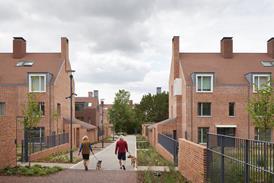Midlands MP says new formula for determining local housing numbers will ’level down’ city targets in favour of shires
Tory MP Neil O’Brien has become one of the first to break ranks with the government’s planning reforms by criticising the proposed formula for determining housing need in local authorities.

The backbench Conservative MP for Harborough, Oadby and Wigston told the Times that the “strange” proposal risked seeing the housing requirement for some cities “stagnate” while the volume of new homes in shires and suburbs rose steeply.
His comments refer to the new proposed “standard method” for determining local housing need, laid out by the government at the start of this month alongside its wider reforms to the system, which will limit democratic involvement in individual planning application decisions.
Under the proposed system, the new housing number generated by the formula will move from being a reference point, against which councils determine their final housing requirement in their local plan, to being the final housing requirement itself.
O’Brien’s remarks come after an analysis of the new formula by planning consultant Lichfields found that applying the new method would see the volume of homes needed in London and the home counties soaring, while other regions of the UK would see their requirement to build remain at current levels or even reduce.
In particular, however, the formula also suggests that for some cities, such as Nottingham and Leicester, the housing requirement will fall from current levels, while the requirement for homes in their surrounding towns and villages will rise sharply.
O’Brien said: “Lots of our large cities have brownfield land and capacity to take more housing and it seems strange when planning to ‘level up’ to be levelling down their housing targets to rates even lower than they have been delivering. It would be quite difficult to explain to Conservative voters why they should take more housing in their areas to allow large Labour-run cities nearby to continue to stagnate rather than regenerate.”
His comments come amid much speculation that the raft of planning reforms unveiled earlier this month could face stiff opposition from some Conservative MPs in rural areas keen to prevent widespread housing development.
However, while Cotswolds Tory MP Sir Geoffrey Clifton-Browne criticised the proposals on the day they were launched, there have been few signs of Conservatives being willing to criticise the government over the plans since then.
The proposals, which will see the introduction of a form of zonal planning to the UK, will force local authorities to zone all land as either for growth, renewal or protection within two and a half years. Land in growth areas will be subject to automatic outline permission.
While many developers have welcomed the reforms - albeit while voicing concerns over the ability of local authorities to deliver the required new plans in the timeframe - the RIBA branded them “shameful”.
The proposed new method for calculating housing need will require each local authority to build a certain number of homes based on a formula using the existing number of homes in the area as a starting point, with a proportionate uplift. It then goes on to factor in projected population growth and relative affordability so that areas with the highest demand see relatively higher figures.
According to Lichfields, the new standard method for calculating housing need will see the requirement for new homes in Leicester fall by 32%, compared with a rise of 51% across Leicestershire, while in Nottingham housebuilding would fall by 22%, but for the rest of Nottinghamshire it would rise by 38.7%. In Liverpool, too, the number of new homes required by the government would fall by 59%.
A spokesperson for the housing ministry told the Times that O’Brien’s concerns were “inaccurate”. “Our proposals will increase the supply of land available for new homes where it is needed,” the spokesperson said, adding that decisions over which areas to target for homes would be made locally.
















No comments yet